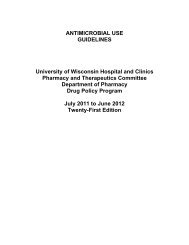Antibiotic Lock Solution Guideline - UW Health
Antibiotic Lock Solution Guideline - UW Health
Antibiotic Lock Solution Guideline - UW Health
You also want an ePaper? Increase the reach of your titles
YUMPU automatically turns print PDFs into web optimized ePapers that Google loves.
addition of an anticoagulant. When ethanol lock solutions are considered, the effect of ethanol on themechanical and structural integrity of the catheter must be considered. 72.0 Objectives2.1 To provide information to clinicians on the appropriate indications, anti-infectiveconcentrations and dwell times for anti-infective flush and lock solutions in pediatric andadult patients with a variety of catheters. Available regimens based on clinical studies orcase reports, not in vitro data.2.2 To provide information on stability and compatibility of solutions.2.3 To include evidence for anti-infectives available at <strong>UW</strong>HC.3.0 Definitions:3.1 Anti-infective lock: solution that is instilled into the lumen of a catheter and removedafter a specified period of time (or when access device next used). The process ofinstillation and removal is the anti-infective lock technique (ALT).4.0 Indications and regimens approved for the use of anti-infective locksolutions in the prevention and treatment of catheter-related bloodstreaminfections. All orders for non-HD catheter ALT requires Infectious Diseaseapproval. HD catheter ALT requires either Nephrology of Infectious Diseaseapproval.4.1 Prophylaxis 84.1.1 Do not routinely use anti-infective solutions to prevent catheter relatedinfections4.1.2 Use prophylaxis with anti-infective lock solutions only in specialcircumstances. Infectious Disease approval is required for non-HDcatheter ALT. Nephrology or Infectious Disease approval required forHD catheter ALT.4.1.2.1 Vascular access device is required for long term/indefinite use andcannot easily be replaced in a patient with a history of catheterrelatedblood stream infections despite stringent infection control.4.1.3 Table 3: Prophylaxis Regimens in long-term CVC: pediatric/adult (non-hemodialysis)Listed concentrations for anti-infective(s) and heparin are final concentrationper ml of admixed solution. Dwell time minimumone hour.Vancomycin Cipro Ceftaz Heparin Dwell time Reference25 microgram 2 microgram 10 unit minimum onehour2 milligram(see 4.1.4)100 unit 2mL lockbetween use2 milligram 100 unit 2mL lockbetween useAbbreviations; Cipro, ciprofloxacin; Ceftaz, ceftazidime910104.1.4 For vancomycin 2 mg/100 unit heparin/mL lock listed above, drawvancomycin concentration (peripheral only) at a mid-point between lockinstillations to check for detectable vancomycin concentration. Theconcentration should be non-detectable.
















